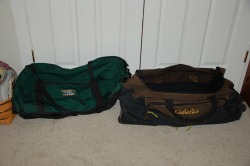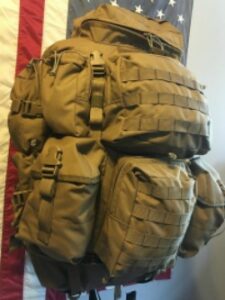 Some preppers and survivalists might scoff at such an idea. After all, beyond the initial 72 or so hours of a bug out scenario, most would think you’d be surviving out of more permanent supply sources than another bag or storage box. Well, you might be, or in some cases, you might not be. SHTF happens. The idea of a secondary supply bag then may not seem like such a bad or far fetched idea.
Some preppers and survivalists might scoff at such an idea. After all, beyond the initial 72 or so hours of a bug out scenario, most would think you’d be surviving out of more permanent supply sources than another bag or storage box. Well, you might be, or in some cases, you might not be. SHTF happens. The idea of a secondary supply bag then may not seem like such a bad or far fetched idea.
By Dr. John J. Woods, a contributing author to SHTFBlog
Every bug out plan however perfectly executed may not pan out exactly as planned. You may have cached out a perfect bug out hiding location, a camping spot, another shelter at a long range destination or other hold over site until calm returns, or a new lifestyle starts. But what if you don’t make that back up site right away or at all?
What if there are delays or outright changes in the plan altogether? What will you do if roadblocks hinder your progress or throw you off on an entirely new route, one you have not practiced or are even familiar with. Suppose riots, armed threats or searches deter you? If any of that happens or more, you’ll need additional survival provisions to survive.
Defining Long Term
 This is obviously the hard part. During any kind of a SHTF, time frames simply cannot be nailed down, or likely even predicted. Everything is in flux, and I mean everything. If you were even successful at getting away from your primary residence, or work with family in tow if that is part of the plan, then you will spend some time in travel. You may have calculated the Bug Out trip in advance knowing how many hours or days it will take to arrive at your back up location, SHTF housing or secure site. Assuming that all works out.
This is obviously the hard part. During any kind of a SHTF, time frames simply cannot be nailed down, or likely even predicted. Everything is in flux, and I mean everything. If you were even successful at getting away from your primary residence, or work with family in tow if that is part of the plan, then you will spend some time in travel. You may have calculated the Bug Out trip in advance knowing how many hours or days it will take to arrive at your back up location, SHTF housing or secure site. Assuming that all works out.
As a suggested back up plan then, or a sort of supplemental Plan B, one should also prepare for the potentiality of an extended short term situation turning into something more. But what? It seems reasonable all else being equal to have emergency provisions beyond the 72-hour scenario for a minimum of two weeks at least with the possibility of a month not being unrealistic.
Back Up Bag Scenario
 Let’s be truthful here, too. In most real Bug Out situations, you do not want to have to plan to abandon your vehicle to hike on foot. It could happen, but it is not a best case scenario to strike out into the woods with a one bag source of supplies. Most of us are simply not equipped physically or emotionally to hike off into the sunset to try to “live off the land.” Perhaps the top tier of survivalists could, even for a while, but it is the toughest plan to achieve.
Let’s be truthful here, too. In most real Bug Out situations, you do not want to have to plan to abandon your vehicle to hike on foot. It could happen, but it is not a best case scenario to strike out into the woods with a one bag source of supplies. Most of us are simply not equipped physically or emotionally to hike off into the sunset to try to “live off the land.” Perhaps the top tier of survivalists could, even for a while, but it is the toughest plan to achieve.
If it comes to it, should you become detoured, plan instead a hide in place by the vehicle on an abandoned road, under a bridge, or other place where your vehicle could be parked relatively safe, and out of sight. Then plan to camp there with your vehicle and supplies as long as you have to or indeed as long as you can. Doubtless this could be a highly “iffy” situation, but it could happen.
Also Read: Knee Deep in Bug Out Vehicles
The vehicle then becomes your fort, your storage container, tent, and thus offering some measure of security and comfort. But, you’ll need the extra extended supplies, goods, and gear to make this viable until you can move on or be forced to hunker down there.
Then later, if you do reach your intended secondary site, these back up provisions can be used there in addition to what you may have already cached in place or hidden along the way. To be honest, if Plan A never works out, and Plan B’s provisions are expended, then basically all bets are off.
You may have to then shelter in place, wherever or whatever that turns out to be. It is not without consideration to think about a scrounging plan as well, but hope it does not come to that. Always remember many others are out there vying for the same limited sources of supplies or even what you have already secured.
Secondary Bag Priorities
 By bag, this could be a very large zippered duffle type bag with triple or more interior space than your initial 72-hour Bug Out type bag. Ideally, it would need sturdy grab handles on each end and perhaps the sides. Loaded such a bag will be heavy. Two people will likely be needed to load it in a vehicle. But, honestly, it does not have to be a bag at all. There are some very large, and of course heavy when loaded as well, storage boxes that can withstand a lot of abuse. These can be packed, locked, and stored in a ready grab spot as a throw in bag/box. This may not be an option for every prepper, but it is a backup worthy of consideration. Again, this bag or box should be provisioned with enough additional consumables and gear to manage the two weeks to a month or even longer term.
By bag, this could be a very large zippered duffle type bag with triple or more interior space than your initial 72-hour Bug Out type bag. Ideally, it would need sturdy grab handles on each end and perhaps the sides. Loaded such a bag will be heavy. Two people will likely be needed to load it in a vehicle. But, honestly, it does not have to be a bag at all. There are some very large, and of course heavy when loaded as well, storage boxes that can withstand a lot of abuse. These can be packed, locked, and stored in a ready grab spot as a throw in bag/box. This may not be an option for every prepper, but it is a backup worthy of consideration. Again, this bag or box should be provisioned with enough additional consumables and gear to manage the two weeks to a month or even longer term.
It would seem the highest priority should go to food, and water, or additional equipment to convert questionable water sources into acceptable water, as not enough could be transported via this plan. Food supplies, also need to be light, and offering long term viability. This means a large quantity of quality pre-packaged survival foods offering maximum variety and palatability. This implies commercial survival foods, dry packages, freeze-dried, and or MRE type meals. Frankly, you can forget carrying canned goods and such as the weight and volume would be too much to handle.
Though debatable as personal choices, a good cooking mess kit should be included as meal prep would be more than munching a protein bar at this point. Minimalist type gear is important, but necessary anyway.
 Add to the long term bag more gear. An axe, more tarp covers, more medical supplies especially medications needed for specific disorders that require treatment. Rope, rough wood saws, a hammer, large nails/spikes, batteries, more matches and butane lighters, candles, more flashlights, zip bags, heavy duty trash bags, work gloves, a knife or two more. Water storage bags would be helpful. Include light fishing gear and/or nets. Add whatever else you can manage. Seasonal clothing as space permits or yet another soft bag?
Add to the long term bag more gear. An axe, more tarp covers, more medical supplies especially medications needed for specific disorders that require treatment. Rope, rough wood saws, a hammer, large nails/spikes, batteries, more matches and butane lighters, candles, more flashlights, zip bags, heavy duty trash bags, work gloves, a knife or two more. Water storage bags would be helpful. Include light fishing gear and/or nets. Add whatever else you can manage. Seasonal clothing as space permits or yet another soft bag?
Add more ammo, perhaps a thousand rounds each for a primary rifle and handgun with half that for a shotgun. Add one or two more weapons if convenient. Sounds extensive? Expensive? Perhaps. You have to make that judgement on what you can handle. These goods are carried by the vehicle and stored there during travel or roadside camping, perhaps for the endurance.
The long term survival bag (LTSB) then is provided to extend the usual 72-hour initial Bug Out period as or if needed. It certainly could come in handy and also in the end supplement what has already been stocked at some alternative sheltering site. It’s just an idea, but one acted upon soon and in hand rather than merely wished for later under more dire circumstances.

12 comments
Very good article! I like the part about “your vehicle becoming your fort”. That’s exactly why I bought a 15 yr old used Dodge Durango 4×4. Not great on gas, but solid as a rock and fun to drive. I could live in it if I had to.
I have lots of my long-term bug out supplies stored in gray plastic totes. I tried the totes with the top folding flaps, but soon realized they are NOT water proof. One of the smaller totes is stored with zip lock bags and small storage containers, mostly containing fire-starting materials. Thanks
Looks like I’ve been kind of doing what you described, but without thinking of it that way. In my truck, besides my Go Bag, are extra tarps, rope, saw, axe, etc. Good to have anyhow for country travel. Per the ammo and such, I’d been making up ammo cans and hard cases for grab-n-go handiness. Other longer term items (tent, sleeping bags, camp goods) are on the shelf above the truck, so they’re already set for grabbing-n-going. Got to work on the grab-n-go solution for water and travel foods.
This is basically what I refer to as my INCH (I’m Not Coming Home) bag and consists of a miltary-style duffel bag filled with #10 cans of FD foods, fourteen of them (though you can fit a total of 16 in it). Twelve of those cans are FD foods because Dehydrated or ‘regular’ canned foods are too heavy to carry. The other two cans have multiple items that are hard to produce in the woods such as candles, disposable lighters, sewing kit, extra razor knife (with more blades), batteries for EDC electronics, screwdriver and 100+ small metal screws, tin snips, roll of duct tape, ammo, etc. With plastic wrapped clothing, plastic tarp and 2 wool blankets (cushions the back) filling the extra space, this weighs just over 60 lbs., but should feed me for about 8 weeks! This is separate from my BOB vest and backpack and weapons/tool bag so I would have to make a second trip to collect it from its hiding place, but I feel that a vehicle (especially unguarded) makes too easy of a target, a locked door will mean nothing to desperate people. Also, the empty cans (with their plastic lids) make very good containers for storage of water, fire tender, foraged food (dried meat), about anything needing to be kept dry and safe from critters! And cut open with the tin snips and connected by metal screws, the used #10 cans may be used for roofing and/or other sturdy construction needs! GLAHP!
The longer you need to be out, and the more gear and supplies you’d need..the more you’ll need wheels…a two wheeled cart can go quite a ways towards lightening an otherwise unbearable load.
What a great article I tell people in my classes all the time keep your Bob and duffle in your car you never know what’s going to happen I make sure I have both in my truck the extra gear, food,that you can take with you can add a lot of time to your survival not to mention barter items sincerely Travis Cole founder and ceo http://www.bugoutsurvivaltraining.com and bugoutsurvivalschool.com
“A moving foxhole attracts the eye” (Willie to Joe , “Up front” by Bill Maulden 1944) If you are on the move you have put a severe limit on not only your survival, but that of everyone in your party. First: It is IMPOSSABLE to man pack more than five days food without resupply. Second: A transport MUST have fuel, and parts to “go”. That limits how far and how long you can go until you are on foot. Once you ARE on foot, 99% will be dead in 90 days or less. The bugouts ARE the “golden hoard” fleeing disaster. This “bugout” idea is a stupid fantasy. No let me correct that ALL BUGOUT IDEAS ARE STUPID FANTASYS. The term you are looking for is “STARVING REFUGEE”. That’s what happens when you “buggout”. You cannot go to the forest and “survive” YOU CAN’T!! It takes 10 square miles per person to survive on hunting and gathering, and YOU MUST move every seven to 14 days to find new hunting grounds. Native Americans survived east of the Mississippi river because they were FARMERS. They myth of the “red hunter” was made up to justify theft and murder. Bugging out is suicide for adults and murder for children.
It’s suicide for most folks. But it is possible for prepared and skilled folks. Obviously, skill and location are major factors but it can be done.
Seems to me that if you have a truck load of gear and supplies, you might as well throw the chainsaw in.
It also seems to me that all “bugout plans” go from higher population densities to lower densities with lower visibility and some hope of sustainability. I’m thinking that the vast majority of your supplies had better already be at your BOL. The idea of transporting high value supplies through road blocks, damaged infrastructure, interrupted fuel delivery, grid down, or freaked out refugees does not seem that viable.
Think of the “gray man” concept of moving through people. You want to be totally unremarkable. You don’t want to look tactical; no cammies, no exposed weapons; no mil-spec ruck. You are basically trying not to be noticed. If its vehicles in long lines or check point or toll booths, or camp grounds in a national emergency bad enough to make you leave your home; a pickup truck full of stuff is going to get you noticed and make you a target
I believe that Ray is incorrect about how much food a person can carry with them. Basic foods like oatmeal, rice, jerky,etc. are very calorie-dense, not too bulky or heavy and FD foods are quite lightweight! But Ray is correct about stating that hunting is not a ‘sure thing’, most people have little experience with hunting or trapping! There are only so many fish in a pond/lake. You would be a ‘starving refugee’ all too soon if you don’t have a place to stay long-term and just as important is the foil-sealed package (usually kept in the fridge) of heirloom vegetable seeds in my INCH bag. A white tag with ‘seeds’ written on it is tied to the opening of my duffel bag so I don’t forget them in the fridge! Wild edibles (if even available) won’t last long when being heavily foraged upon, agriculture is a must for long-term survival/living! GLAHP!
the best long term survival strategy, is to be far, far away from the bad situation.
I can’t afford to be a “world traveller”, but I keep a duffel ready for the opportunity. your luggage might not arrive. I’m making a “carry on bag” of essentials, to keep closer.
in my mind, I’m trying to convince the youngest in our party
(and myself) that we’re on a really exciting vacation.
If the loan limit drops significa Wholesale Galaxy S8 ntly, the loans that fall within their purview will be irrelevant in the higher priced markets. The median price of a home in the San Francisco Bay Area was over three quarters of a million dollars in June of 2006. In some counties within the metro area, the median